Call it a whim or destiny, but when teenage Rangers fan Bobby Pollock and his two pals had a change of heart and exited Ibrox Stadium by Stairway 14 rather than the ill-fated 13, it quite possibly saved their young lives.
Bobby’s mum, Irene, had made no secret of the fact that she didn’t want her 15-year-old boy going to his first Old Firm game on January 2, 1971.
She and his dad, Ian, discussed it in hushed tones; she maintaining that Bobby was too young – and everyone knew that when the bitter rivals clashed, Glasgow often became explosive.
“I was a young boy, just starting to support Rangers, and I wanted to go to every single match, home and away. But I had never been to an Old Firm game,” remembers Bobby.
“My mother and father had a debate about it. My father was a typical male, saying there was nothing wrong with it.
“A couple of my pals were going. I could have decided not to tell my parents, and gone anyway. For a boy who’d just turned 15, that would have been a pretty normal thing to do.
“Now, though, I always think at the back of my mind: what if I had not told them, then got caught up in the tragedy that unfolded.”

His dad’s persuasive “let the lad go” won out, and Bobby, friend Ken Forbes and another pal set off that fateful day, giddy with excitement, for the 30-minute walk from Cardonald to Copland Road.
“I remember it clearly,” said Bobby.
“It was a very cold, damp, misty day.
“We always sat right in the middle of the traditional Rangers End – terracing, as they called it. You stood where you wanted to stand. There were only two exits at the terracing, Stairway 13 and Stairway 14. We were half way down the terracing, right in the middle. You used to watch the build-up at both ends, the singing and chanting. From where we were, you couldn’t see the Celtic End because of the mist.
“It was nothing each, with one minute of the game left. Then, Celtic scored in the last minute, into the end we were in. Rangers supporters assumed we’d lost, and a lot started heading for the exit.
“Fortunately, we decided we’d stay. The final whistle hadn’t gone and there was a minute or two of injury time.
“Rangers got a free kick, and the ball got kicked into the mist. Five seconds later, Rangers players could be seen jumping up out of the mist. It was an equaliser with the last kick of the ball.
“Fans all around us were jumping about. We waited five minutes or so and started heading towards the exits. And, for whatever reason, we went to Stairway 13.”
As the boys approached, they could see the top of the steep staircase was packed – and they took the decision to head instead for Stairway 14, from which they exited Ibrox and strolled up Copland Road towards home, clutching their programmes, oblivious to the tragedy unfolding outside the stadium they had just left.
“As I keep saying to my own two sons, these were the days before mobile phones and social media. People were not texting each other,” continued Bobby, of Croftfoot.
“All we heard for the next 30 minutes was sirens. At Rangers-Celtic games, that was not unusual. What we didn’t know was, it was lots of ambulances heading to Ibrox.”
By the time Bobby returned home, his anxious maternal grandfather had called three times. He’d heard there had been a crushing incident at Ibrox and “a couple of fans” had lost their lives.
“I phoned him just to reassure him, and he said: ‘I am so glad you are home, son. Thank God you are okay. There’s been a terrible crush at the exit at the Rangers End’,” remembers Bobby.
“Somebody had fallen, tripped, and somebody fell on top of them. At that time, they were saying there were quite a number of serious injuries, with two people dead.
“In those days you got 30-second television newsflashes, interrupting programmes, saying they were going over to Glasgow, to Ibrox. All the channels had cameras there. It was dark, and Glasgow looked bleak. The reality of the events that had happened there made it look even worse.

“The number of dead went from two, to eight, to 16. By the time I went to bed, there had been 20 people killed.
“The next morning, I took the dog for a walk to get the newspaper. The Sunday Mail front page said ‘66 Dead’. All the way home, I just stared at that headline. Because of my age, how do you take that in? One incident. How is that possible, for 66 people to die?”
When Bobby went to Pennilee Secondary School the following day, one boy in his class and his brother were noted absent on the morning register. Their dad had lost his life in the horror.
To this day, Bobby – who is now a 65-year-old grandfather to 15-month-old Robyn – can recall the game, his elation at the equalising goal and the walk home, but he can’t remember his parents’ words when he got there.
Years later, Bobby’s father-in-law recalled being at a golf club dance that ill-fated day in 1971, when a member of the committee failed to turn up. He, too, had been caught up in the crush and died at the scene.
It was one of a number of stories told to Bobby over the years by people whose own lives, or those of friends and loved ones, had been touched by the disaster of which, as a teenage schoolboy, he’d been on the periphery.
During Bobby’s career in housing, a colleague told how, as a 16-year-old, he was caught up in the mayhem on Stairway 13.
He had fallen, and a stranger grabbed his raised arm and pushed him out of the crush and on to grass and nearby ambulance crews.

It’s been a long time since Bobby cheered on his team from the stadium that has been acknowledged as one of the safest in Europe for almost 40 years.
Now an enthusiastic supporter of Pollok FC, he sometimes wonders if part of the appeal of junior football is being among a smaller crowd.
Like many of his school pals, a young Bobby had a prized collection of match programmes, many of which he ditched during house moves over the years.
But there is one that he refuses to part with.
It’s that of the Old Firm clash of January 2, 1971 – the programme that he clutched on his walk home on a day that was to change the landscape of football forever, and shattered scores of families’ lives.







